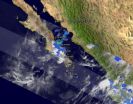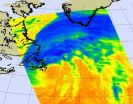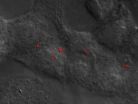(Press-News.org) The GOES-13 satellite may be stationed in orbit over the eastern U.S., but it has a wide field of view from the eastern Atlantic to the eastern Pacific, and today it captured three tropical cyclones in one image.
At 1445 UTC (10:45 a.m. EDT) today, Sept. 22, the Geostationary Operational Environmental Satellite called GOES-13 captured Tropical Storm Lisa in the far eastern Atlantic, a developing tropical low in the south-central Caribbean Sea, and Tropical Storm Georgette in the eastern Pacific Ocean, making landfall in Baja California. The GOES series of satellites are managed by NOAA, and NASA's GOES Project at NASA's Goddard Space Flight Center in Greenbelt, Md. creates images and animations from the satellite data.
Tropical Storm Lisa is struggling today in the eastern Atlantic Ocean because of wind shear and dry air. Lisa was producing a small area of deep convection near the surface of her center of her circulation. The center of circulation is also exposed to outside winds, which make the storm prime for weakening. In addition, there is a lot of dry air around Lisa at the middle levels of the troposphere (likely from the Saharan dust that has been blowing off the African coast). All of those things are indicators why Lisa has not been able to intensify.
The Tropical Rainfall Measuring Mission (TRMM) satellite passed above Lisa on Sept. 21 at 2309 UTC (7:09 p.m. EDT) and revealed a few areas of moderate to heavy thunderstorms with rain falling at about 2 inches per hour within the storm's circulation.
At 11 a.m. EDT on Sept. 22, Lisa had maximum sustained winds near 45 mph. The National Hurricane Center noted that some strengthening is possible over the next 48 hours, so the environmental conditions should become more conducive for the tropical cyclone. Lisa was 435 miles west of the Cape Verde Islands, near 17.1 North and 30.5 West. It was moving very little in a southeasterly direction at 3 mph and is forecast to move little in the next couple of days. Estimated minimum central pressure is 1002 millibars.
Meanwhile, there is a low pressure area in the south-central Caribbean Sea that forecasters are watching. Today's GOES-13 satellite image does show some circulation in the clouds associated with the low. NOAA's National Hurricane Center (NHC) noted that this low has the potential to become the 15th tropical depression of the Atlantic Ocean hurricane season over the next day or two. In fact, NHC gives the low a 60 percent chance of making the grade to tropical depression in 48 hours. That low is expected to bring showers and squalls over the Netherlands Antilles and the northern coasts of western Venezuela and Colombia today.
Further west, Tropical Depression Georgette has already crossed over Baja California and is now headed to another landfall on the mainland in Mexico. A tropical storm watch is in effect for the coast of mainland Mexico from Huatabampito Northward to Bahia Kino.
When the Tropical Rainfall Measuring Mission (TRMM) satellite passed over Georgette on Sept. 22 at 0344 UTC ( Sept. 21 11:44 p.m. EDT) the tropical depression had isolated moderate thunderstorms near the center with rainfall between .78 to 1.57 inches per hour.
Georgette is a tropical depression with maximum sustained winds near 35 mph. It is located in the Sea of Cortes (the Gulf of California) and is about 85 miles south of Guaymas, Mexico. It is centered near 26.8 North and 111.0 West, with a minimum central pressure of 1000 millibars.
The depression is moving toward the north-northwest near 14 mph and is expected to turn north later today making landfall tonight. The NHC noted that "Georgette is expected to produce total rainfall accumulations of 4 to 6 inches over the western portions of the state of Sonora with isolated maximum amounts of 10 inches possible."
INFORMATION:
GOES-13's wide view of Atlantic's Tropical Storm Lisa and low, Pacific's Georgette
2010-09-22
ELSE PRESS RELEASES FROM THIS DATE:
Huge post-tropical Hurricane Igor drenched Newfoundland, Canada
2010-09-22
Hurricane Igor may have transitioned into a post-tropical hurricane late yesterday, but when he approached Newfoundland, Canada and merged with an area of low pressure it resulted in heavy rainfall throughout the region. NASA satellites captured Igor's northern march toward the Labrador Sea yesterday.
NASA's Terra and Aqua satellites captured visible and infrared images of Hurricane Igor yesterday as he brought heavy rainfall into northeastern Canada. A visible image of Hurricane Igor over Newfoundland, Canada was captured by the Moderate Resolution Imaging Spectroradiometer ...
Human-powered ornithopter becomes first ever to achieve sustained flight
2010-09-22
TORONTO, ON – Aviation history was made when the University of Toronto's human-powered aircraft with flapping wings became the first of its kind to fly continuously.
The "Snowbird" performed its record-breaking flight on August 2 at the Great Lakes Gliding Club in Tottenham, Ont., witnessed by the vice-president (Canada) of the Fédération Aéronautique Internationale (FAI), the world-governing body for air sports and aeronautical world records. The official record claim was filed this month, and the FAI is expected to confirm the ornithopter's world record at its meeting ...
Humanized mice may provide clues to better prevent and treat typhoid fever
2010-09-22
Better treatments and prevention for typhoid fever may emerge from a laboratory model that has just been developed for the disease. The model is based on transplanting human immune stem cells from umbilical cord blood into mice that are susceptible to infections.
The transplanted cells live alongside the mouse's own immune system. Although mice are normally resistant to the dangerous strain of Salmonella that causes typhoid fever, the bacteria are able to reproduce in the mice that have received transplanted human cells.
Because typhoid fever affects only humans, ...
Positive behavioral interventions programs found to improve student behavior and learning
2010-09-22
Los Angeles, CA (September 22, 2010) Adopting the evidence-based procedures of School-Wide Positive Behavioral Interventions and Supports (SWPBIS) helped 21 elementary schools reduce student suspensions, office discipline referrals and improve student academic achievement, according to a study published in the July 2010 issue of the Journal of Positive Behavior Interventions. SWPBIS is a rapidly expanding approach to improving educational environments that is estimated to be used in more than 9,000 schools nation-wide
Researchers at the Johns Hopkins Center for the Prevention ...
Experience, privacy guide how people choose online news
2010-09-22
Adjustments, applications and other tools allow users to configure preferences and use services such as iGoogle and Yahoo to control and customize the news they consume online. These tools can make online experiences more efficient and productive, but they do not ensure that users will be consistently pleased with their selections, according to Penn State researchers.
"There is a major push toward customization in the marketplace because designers assume that more customization is better, but our research shows that only some users prefer customization," said S. Shyam ...
Losing your religion deemed unhealthy
2010-09-22
People who leave strict religious groups are more likely to say their health is worse than members who remain in the group, according to a Penn State researcher.
The percentage of people who left a strict religious group and reported they were in excellent health was about half that of people who stayed in the group, said Christopher Scheitle, senior research assistant, in sociology.
"Previous research showed some association between belonging to a religious group and positive health outcomes," Scheitle said. "We became interested in what would happen to your health ...
Gum disease found to be significant public health concern
2010-09-22
September 21, 2010 – Chicago – The prevalence of periodontal disease in the United States may be significantly higher than originally estimated. Research published in the Journal of Dental Research from the Centers for Disease Control and Prevention (CDC) and the American Academy of Periodontology (AAP) suggests that the prevalence of periodontal disease may have been underestimated by as much as 50 percent. The implication is that more American adults may suffer from moderate to severe gum disease than previously thought.
In a National Health and Nutrition Examination ...
Study: Doctors overprescribe antibiotics for respiratory infections
2010-09-22
Doctors frequently misuse antibiotics when treating patients hospitalized with respiratory tract infections (RTIs), according to a study to be published in the November issue of Infection Control and Hospital Epidemiology.
The study, which tracked patients in two Pennsylvania hospitals, found that doctors often use antibiotics to treat patients whose infections are known to be caused by viruses. The findings are alarming because antibiotics are not effective against viruses, and antibiotic overuse has been linked to the development of resistant bacterial strains.
"[T]hese ...
Introducing 'Champagne,' new disease-resistant fig
2010-09-22
BATON ROUGE, LA—The ancient fig tree, first imported to the United States during the 16th century, thrives in areas of California and the South Atlantic and Gulf Coast areas of the U.S. One of the most popular trees grown in Southern backyards, fig is favored for its versatile fruit and low-maintenance production.
Charles E. Johnson, Ed O'Rourke, and James E. Boudreaux, from the Louisiana State University Agricultural Center in Baton Rouge, introduced a new fig they named "Champagne" in a recent issue of HortScience. According to the report, the new fig performed well ...
Food for thought, er, well ...
2010-09-22
Ever wonder why it's such an effort to forget about work while on vacation or to silence that annoying song that's playing over and over in your head?
Mathematicians at Case Western Reserve University may have part of the answer.
They've found that just as thinking burns energy, stopping a thought burns energy - like stopping a truck on a downhill slope.
"Maybe this explains why it is so tiring to relax and think about nothing," said Daniela Calvetti, professor of mathematics, and one of the authors of a new brain study. Their work is published in an advanced online ...


